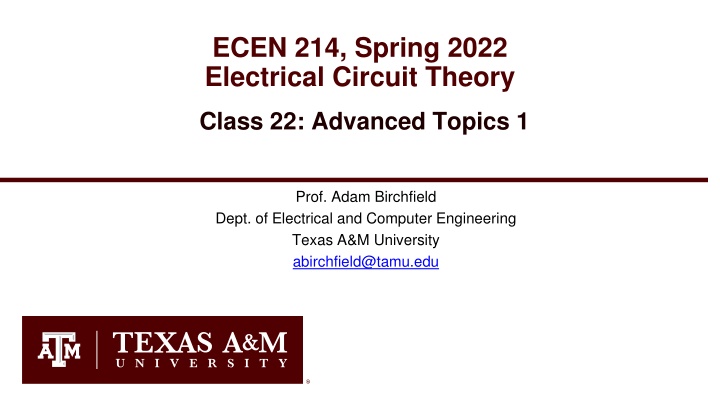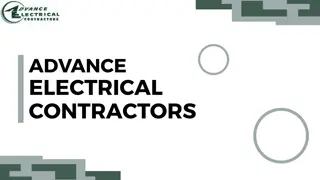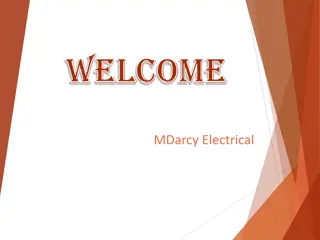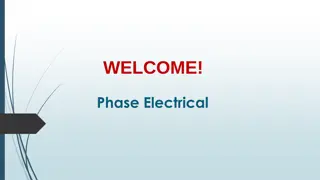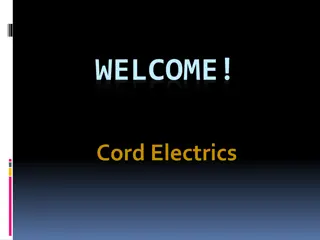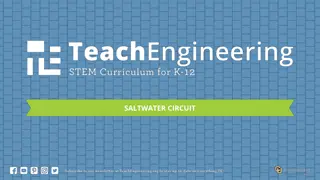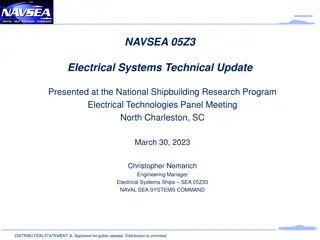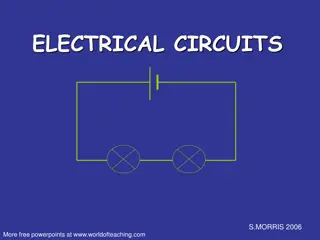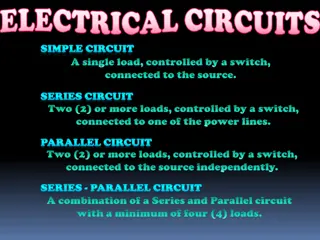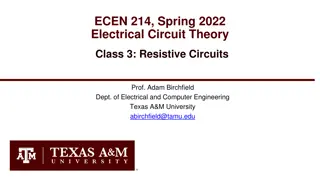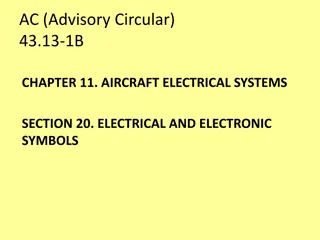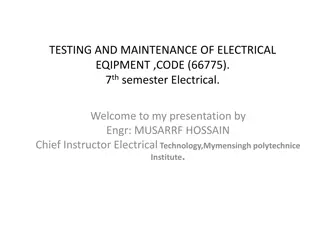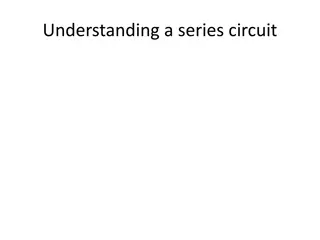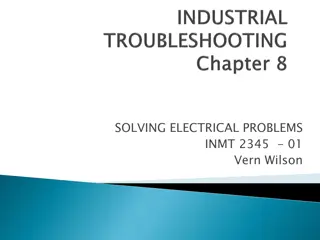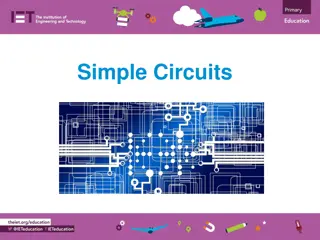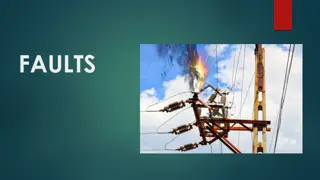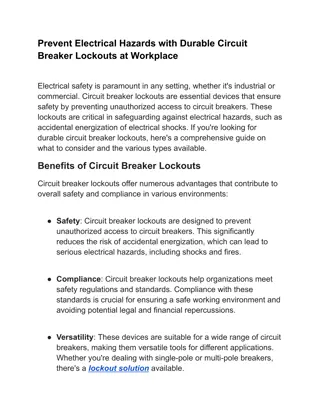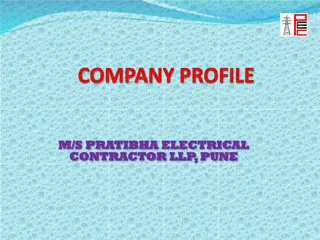Electrical Circuit Theory Class: Advanced Topics with Prof. Adam Birchfield
In this Electrical Circuit Theory class, explore advanced topics such as Computer Simulation of Electric Circuits, Three-phase AC Power Systems, Ideal Transformers, and more. Learn about linear and non-linear circuit elements, the difference between linear and non-linear circuits, and the significance of non-linearities in digital technology development. Prepare for the upcoming exams and discover the opportunities for internships, industry jobs, entrepreneurship, research, or further studies. Enhance your understanding of circuit theory and electrical engineering concepts with Prof. Adam Birchfield at Texas A&M University.
Download Presentation

Please find below an Image/Link to download the presentation.
The content on the website is provided AS IS for your information and personal use only. It may not be sold, licensed, or shared on other websites without obtaining consent from the author.If you encounter any issues during the download, it is possible that the publisher has removed the file from their server.
You are allowed to download the files provided on this website for personal or commercial use, subject to the condition that they are used lawfully. All files are the property of their respective owners.
The content on the website is provided AS IS for your information and personal use only. It may not be sold, licensed, or shared on other websites without obtaining consent from the author.
E N D
Presentation Transcript
ECEN 214, Spring 2022 Electrical Circuit Theory Class 22: Advanced Topics 1 Prof. Adam Birchfield Dept. of Electrical and Computer Engineering Texas A&M University abirchfield@tamu.edu
2 Where You Go From Here Exam 3 next class Three more classes with advanced topics and review (conceptually may be on final) Mon 25 April Advanced topics 2: Computer Simulation of Electric Circuits (bring your laptop) Wed 27 April Advanced topics 3: Three-phase AC power systems Mon 2 May Advanced topics 4: Ideal Transformers Final Exam Friday 6 May at 3:30pm The door to the rest of your major is now open: 325 Electronics 314 Signals Electives (21 hours) 214 Circuits 350 Comp. Arch. 322 E-mag 460 Power Systems Elective Birchfield Spring 2023 403/404 Capstone 248 Digital 340 Power 303 Random 370 Materials (Required) What s next? Internships, industry job opportunities, entrepreneurship Undergraduate research, graduate school for Masters or PhD
3 Introduction to Non-Linear Circuit Elements Linear versus non-linear Scaling: double the input and you get double the output ? ? ? = ? ?(?) Adding: add two inputs and you can also add the outputs ? ? + ? = ? ? + ?(?) Examples of linear circuit elements Resistors ? = ?? Capacitors and inductors: ? = ??? ?? and ? = ??? ?? Linear voltage and current sources (AC and DC) Op-Amps inside the linear region, transformers Examples of non-linear elements Switches, fuses, breakers, relays Diodes, transistors Non-linear control systems, saturated op-amps Non-ideal resistors, capacitors, inductors, sources, amplifiers, transformers
4 Linear Versus Non-Linear Linear circuits are certainly simpler mathematically! We can solve linear circuits with matrices. Next week we ll discuss more systematic methods for computer simulations of linear Electromagnetics itself is linear Maxwell s equations The development of semiconductor technology by taking advantage of highly-nonlinear properties in materials in the 1930s and 1940s enabled digital technology which is built on nonlinearities. Allows the storage and communication of digital information by switching signals on and off James Clerk Maxwell (1831-1879) of Scotland developed the theory of electromagnetism we still use today. It is completely linear and applies even with quantum or relativistic effects.
5 Mechanical Relays Mechanical relays are non-linear control devices that work by opening or closing contacts when a coil is energized Current through the coil moves the electromagnet. If the current gets above a pickup value, it closes the output contacts This allows a smaller voltage to control a much larger one Examples: thermostat turning on your air conditioning, opening a power line when a fault is detected Digital relays can achieve a similar effect with more features using a microprocessor Contact position Mechanical Relay Output Contacts Electro- magnet Coil Spring Circuit Symbols Closed Relay coil (not source) Open Coil current Pickup current Relay contacts (not capacitor)
6 Diodes and Transistors Diodes and transistors are built with semiconductors such as silicon You will learn more about them in ECEN 325 and other electronics classes They are highly nonlinear A diode is a two-port device. High-level idea: For current going one direction, resistance is very small For current going the opposite direction, resistance is higher This allows the device to act somewhat like a check valve A transistor is a three-port device. High-level idea: The voltage on the gate port on the left side controls the current flowing between the two ports on the right They are used to build gates and latches for digital electronics and are the fundamentals of a processor chip Op-Amps are built with multiple transistors
7 Converting AC to DC, AC to AC, DC to DC, DC to AC You ll learn much more about these in ECEN 340 and power electronics classes Converting AC to DC is known as rectifying A simple version can be done with a diode and capacitor Example: iPhone charger. Wall outlet is AC and phone operates on DC with battery Converting DC to AC is known as inverting Also requires both linear and non-linear elements (usually transistors and capacitors) Example: Solar panel conversion equipment. Photoelectric effect creates DC voltage, need to invert to AC to supply to the electric grid. Converting DC to DC with a different voltage can be done multiple ways Linearly: very inefficient such as resistance-based voltage divider Non-linear: boost or buck converters Example: main computer systems run on 48 VDC, but chip needs 5 VDC Converting AC to AC different voltages can be done linearly with a transformer Converting AC to AC with different frequencies is nonlinear Example: wind turbine has variable frequency input depending on wind speed, need to convert to constant grid frequency of 60 Hz
